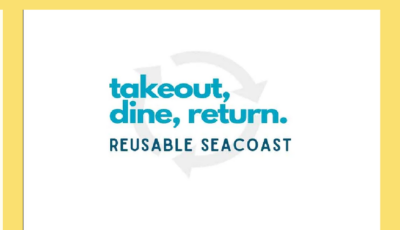Sign up for daily news updates from CleanTechnica on email. Or follow us on Google News!
When you arrive at a restaurant, you’re ravenous, and you order more food than you can eat. Inevitably, you need a takeout container to transport the leftovers home. Most people accept takeout food in single-use containers, and data shows that most diners are aware of the waste issues associated with their consumption.
The restaurant takeout food option infuses convenience to everyday lives, especially for full-time workers. Yet that advantage comes at a cost of environmental pressure from waste packaging materials. There is good news, however: restaurant takeout containers provide a satisfactory function while also reducing environmental pollution. It’s already happening on the New Hampshire coastline, with quite positive results.
Currently, only 20% of waste packaging materials are recycled worldwide. Using food and drink disposable containers has heavy environmental and economic consequences. A need exists to develop more green takeout packaging materials and continuously improve relevant policies and regulations to promote the sustainable development of the takeaway industry.
How can we inspire takeout consumers to react to their materiality and see their choices as inseparable from healthy life and living?
Major restaurants, fast food restaurants, snacks, and even fruit and fresh produce are beginning to venture into the takeout field. Food takeout waste includes disposable lunch boxes, disposable tableware, napkins, bags, and food residues. The chemical materials themselves, which are difficult to degrade, as well as the soup, grease, and food residues left behind, cause direct or indirect pollution to the atmosphere, water, and soil.
Although compostable packaging has increased due to rising customers’ demand for eco-friendly products, composting is often impossible because of lack of organic waste sorting facilities in public spaces and businesses. Isn’t the better option not to produce waste in the first place by using an appropriate reusable containers system? Once adapted to the local context and food, they could work for consumers and the environment.
Green packaging means that, while meeting the functional requirements of product packaging, no burden to the environment results, and no harm to human health throughout the life cycle emerges. Additionally, the materials must be able to be recycled and reused.
In more and more European countries, laws and regulations require reusable containers for to-go food. Sometimes it’s as simple as connecting these businesses with the resources they need to streamline their path to sustainability. Then again, certain variables have to be incorporated into a successful reusable container system.
- The number of reuses is critical in lowering reusables’ environmental impact.
- Materials, weight, and distance to cleaning facilities must be considered.
- Solid, light containers must have an incentive return system to maximize reuse.
Many people are willing to change their restaurant takeout habits but do not think it is possible or do not know concretely how to do so. A series of ways to normalize reusable container habits can make a difference:
- Make the use of reusables visible and easy.
- Exhibit reusables more prominently than single-use containers.
- Offer primarily reusables when takeaway is asked.
- Keep single-use aside and provide only if explicitly asked.
- Display a map of partner restaurants to reinforce reusables.
- Remind consumers to grab their own container in the morning or at lunchtime so it becomes a reflex.
- Activate alerts that prompt consumers at critical times (just before people leaving their home to go to work, or just before lunchtime) to take reusables with them.
Reusable Takeout Containers Get Positive Vibes along the Northern New England Coast
Four New Hampshire seacoast restaurants are asking their dining guests to imagine takeout food that involves less trash. The restaurants have agreed to test out a pilot program that offers reusable takeout containers instead of single-use boxes, with the goal of reducing waste and protecting the environment from plastic pollution.
As reported over the summer by the Boston Globe, Betsy Samber, 26, who owns Juniper Kitchen in Dover, said the first-of-its-kind program has been a success so far at her vegan restaurant. “A lot of our customers are very eco-conscious and care about not creating a lot of waste,” she explained. “So I just knew it would be something that our customer base would be really supportive of and interested in and excited about.”
The reusable program is connected to an app called FoodWare, which tracks the containers. Customers can even choose a style of reusable container when they order food to go. They use the FoodWare app to scan a QR code for the restaurant and a separate code for the specific container. Customers have two weeks to return the container to the restaurant to avoid a $15 fee. “People are really grateful that we’re offering something like an alternative to compostable or disposable containers,” Samber noted.

With 50 free stainless steel containers from Reusable Seacoast, Samber has joined Ohana Kitchen and Ceres Bakery in Portsmouth and HiFi Burritos in Dover in the trial run of the new type of takeout packaging.
So far, there have been enough containers for everyone who’s needed one, and customers have been responsible in returning them to the restaurants, which then wash and sanitize them according to board of health standards.
The initiative was spearheaded by Christina Dubin and Kristine Baber, who have worked on plastic issues together for years through a statewide environmental coalition called the New Hampshire Network. That organization recognizes that the state can do a better job of meeting the threats of climate change, that there are new technologies available, and that an immediate transition to a clean, fair energy system will offer strong protection of the shared environment.
The two said they already had built relationships with restaurants through a campaign called NH Skip The Stuff that encouraged restaurants to provide only single-use takeout items like cutlery and straws upon request.
Skip The Stuff (“STS”) is a national campaign that aims to reduce foodware waste by ensuring that restaurant takeout orders do not automatically include single-use accessories such as plastic utensils, straws, condiments, and napkins. Under an STS policy, these items would be added only upon request by the customer. STS was originally developed by Upstream Solutions (which offers an STS “toolkit” of campaign resources), and there are multiple models from other organizations including Just-Zero and Beyond Plastics. STS campaigns have since been taken up by environmental advocacy groups around the country.
New Hampshire is in the midst of addressing significant waste management issues. The state’s waste policies were not designed to reduce or avoid waste generation, which has contributed to the state’s dwindling landfill capacity. The New Hampshire Department of Environmental Services has estimated that the state may run out of landfill space—both public and private—by the mid-2030s. State policymakers are calling for a new waste management framework that promotes waste reduction and avoidance over recycling and landfilling.
Have a tip for CleanTechnica? Want to advertise? Want to suggest a guest for our CleanTech Talk podcast? Contact us here.
Latest CleanTechnica.TV Videos
CleanTechnica uses affiliate links. See our policy here.
CleanTechnica’s Comment Policy




